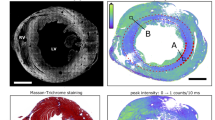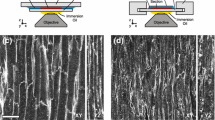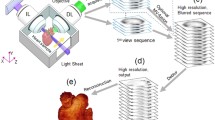Abstract
Background. Scientists are now able to alter the genetics of vertebrate embryos routinely to produce animal models of human developmental diseases. However, our understanding of structural changes in these animal models is limited by current methodologies. Histological techniques, although providing great anatomic detail, display only “static” data (one time point only) in two dimensions. Ultrasound may be used to generate continuous time course data, but is limited by interobserver variation, limited acoustic windows, and relatively low resolution.¶Objective. To apply the high resolution, non-destructive, and three-dimensional acquisition capabilities of magnetic resonance (MR) microscopy to compare the hearts of normal mice versus an established transgenic mouse model of dilated cardiomyopathy.¶Materials and methods. Transgenic mice exhibiting dilated cardiomyopathy were developed via the introduction of a mutated, heart-specific gene (myosin light chain). Post-mortem cardiac imaging was performed on the transgenic mice and normal controls. MR imaging was performed on a Bruker 3T imaging magnet using a custom radiofrequency coil following contrast perfusion of the atrial and ventricular chambers. Image resolution was 156 μm isotropic voxels. MR images were compared to gross pathologic specimens. Imaging data were post-processed using custom software to calculate the volumes of the atria and ventricles and to display the three-dimensional morphology of the chambers and myocardium.¶Results. Of the seven mice scanned, four exhibited normal right atrial (average = 14.8 μl ± 1.4), left atrial (average = 8.5 μl ± 0.3), right ventricular (average = 12.9 μl ± 2.7), and left ventricular (average 3.3 μl ± 0.5) volumes. Three mice exhibited dilatation of the right and left cardiac chambers (RA average = 23.9 μl ± 5.6; LA average = 15.9 μl ± 4.8; RV average = 32.5 μl ± 6.8; LV average 24.0 μl ± 1.4). The gross morphology was verified upon autopsy of the animals and correlated with the animal's genotype. The differences in volumes between the normal and dilated cardiomyopathy mice were statistically significant ¶(P values ranged from 0.001 to 0.024 for the different chambers).¶Conclusion. MR microscopy is a potentially useful tool for developmental biology research. The imaging of mouse hearts is feasible, and these methods provide quantitative and qualitative morphologic data of a mouse model of dilated cardiomyopathy not available using traditional methods.
Similar content being viewed by others
Author information
Authors and Affiliations
Additional information
Received: 27 April 2000/Accepted: 28 August 2000
Rights and permissions
About this article
Cite this article
Sze, R., Chan, CB., Dardzinski, B. et al. Three-dimensional MR microscopy of a transgenic mouse model of dilated cardiomyopathy. Pediatric Radiology 31, 55–61 (2001). https://doi.org/10.1007/s002470000365
Issue Date:
DOI: https://doi.org/10.1007/s002470000365




